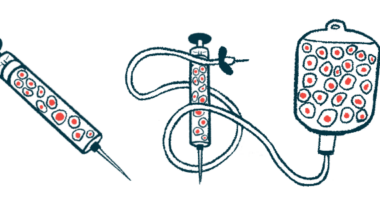Parkinson’s gene therapy increases brain GCase in nonhuman primates
CAP-003 may restore enzyme high enough to prevent alpha-synuclein buildup

Low to moderate doses of CAP-003, a gene therapy in the pipeline from Capsida Biotherapeutics, increased levels of glucocerebrosidase (GCase), an enzyme that’s missing or faulty in some people with Parkinson’s disease, in the brain of nonhuman primates.
Given as a one-time infusion into the vein, or intravenously, CAP-003 may be able to restore GCase enough to prevent the buildup of unwanted proteins, such as the alpha-synuclein toxic clumps that cause Parkinson’s to develop and progress.
Because CAP-003 is designed to head toward the brain, it may also avoid many of the unwanted side effects of gene therapy, according to the company, which plans to move the therapy into clinical testing next year.
“Our novel wholly owned … gene therapy demonstrates the potential to provide long-term significant decrease in disease progression safely with a single [intravenous] infusion,” Peter Anastasiou, Capsida’s CEO, said in a press release. “We look forward to advancing this best-in-class program into clinical development in the first half of 2025, so that we can bring this important treatment option to people suffering from this devastating disease.”
Preclinical findings in nonhuman primates were presented by Nicholas Flytzanis, PhD, Capsida’s chief research and innovation officer, at the American Society of Gene & Cell Therapy (ASGCT) 2024 annual meeting, which took place this month in Baltimore. The presentation was titled “Systemic AAV Gene Therapy with CNS-Targeted Engineered Capsids Achieves Significant GCase Activity Increases in the Primate Brain to Support the Potential Treatment of GBA-PD.”
Up to 15% of people with Parkinson’s carry mutations in the GBA gene, which codes for GCase. When this enzyme is faulty or missing, alpha-synuclein builds up and forms into clumps that are toxic to nerve cells, causing motor and nonmotor symptoms of Parkinson’s.
What does CAP-003 do for GCase levels?
Replacing the faulty or missing GCase with a working copy of it may help ease Parkinson’s associated with mutations in the GBA gene, a form of the disease that usually begins at a younger age and tends to progress faster into more advanced stages. Previous approaches have failed to cross the blood–brain barrier, the semipermeable membrane that keeps many medications from getting into the brain where they’re needed, or provide enough of the enzyme to show a therapeutic benefit, however, the company said.
CAP-003 is designed to deliver a working version of the human GBA gene to nerve cells. The gene is packaged aboard a capsid, or delivery vehicle, that’s been engineered from an adeno-associated (AAV) virus deemed harmless to humans.
When infused into the bloodstream, CAP-003 heads toward the brain. Once there, the working gene is unloaded from the capsid and nerve cells can use its instructions to produce GCase on their own. This should increase the enzyme, thereby easing symptoms and slowing disease progression.
Given at low to moderate doses to nonhuman primates, CAP-003 was introduced into up to 60% of dopaminergic neurons in the substantia nigra and up to 70% in other brain regions. As a result, GCase activity increased up to 45% over wild-type, or, healthy levels. Dopaminergic neurons are responsible for producing dopamine, a chemical messenger essential for motor control, and are gradually lost to the disease. The substantia nigra contains a high concentration of dopaminergic neurons and is especially affected in Parkinson’s disease.
“Estimated average levels of GCase activity increase within transduced neurons surpass 100% of wild-type levels and are expected to more than normalize the enzymatic activity deficit in human patients,” the researchers wrote.
Typically, most of an infused gene therapy ends up in the liver, meaning high doses are needed to get even a small fraction into a target organ such as the brain. But there high doses bring unwanted side effects such as damage to the liver.
Compared with an often-used viral capsid, CAP-003 accumulated 16 times less in the liver. This means restoring GCase levels “throughout the brain can be achieved at doses that are well tolerated,” the researchers said.







